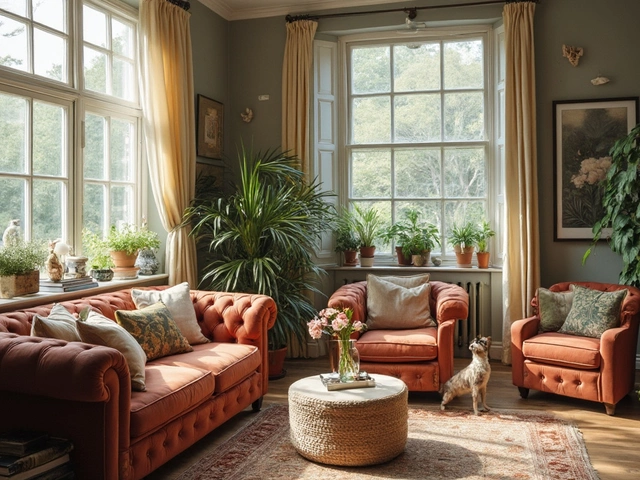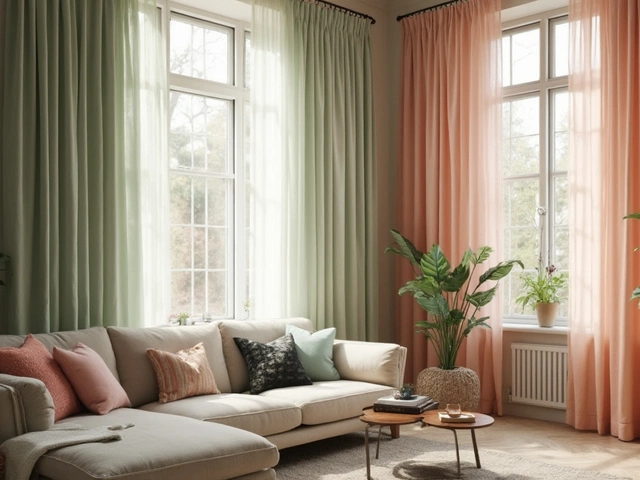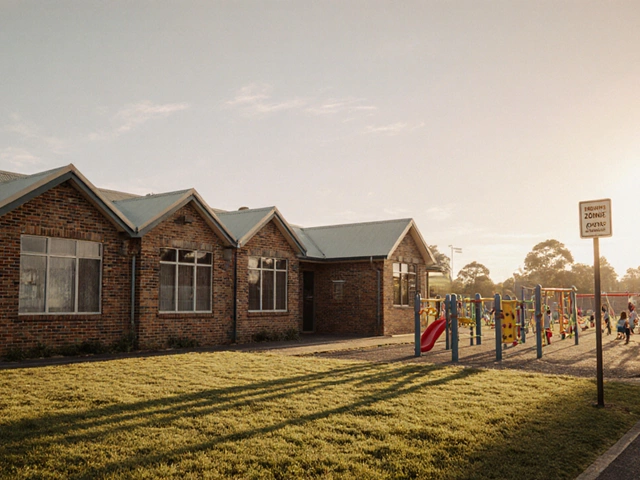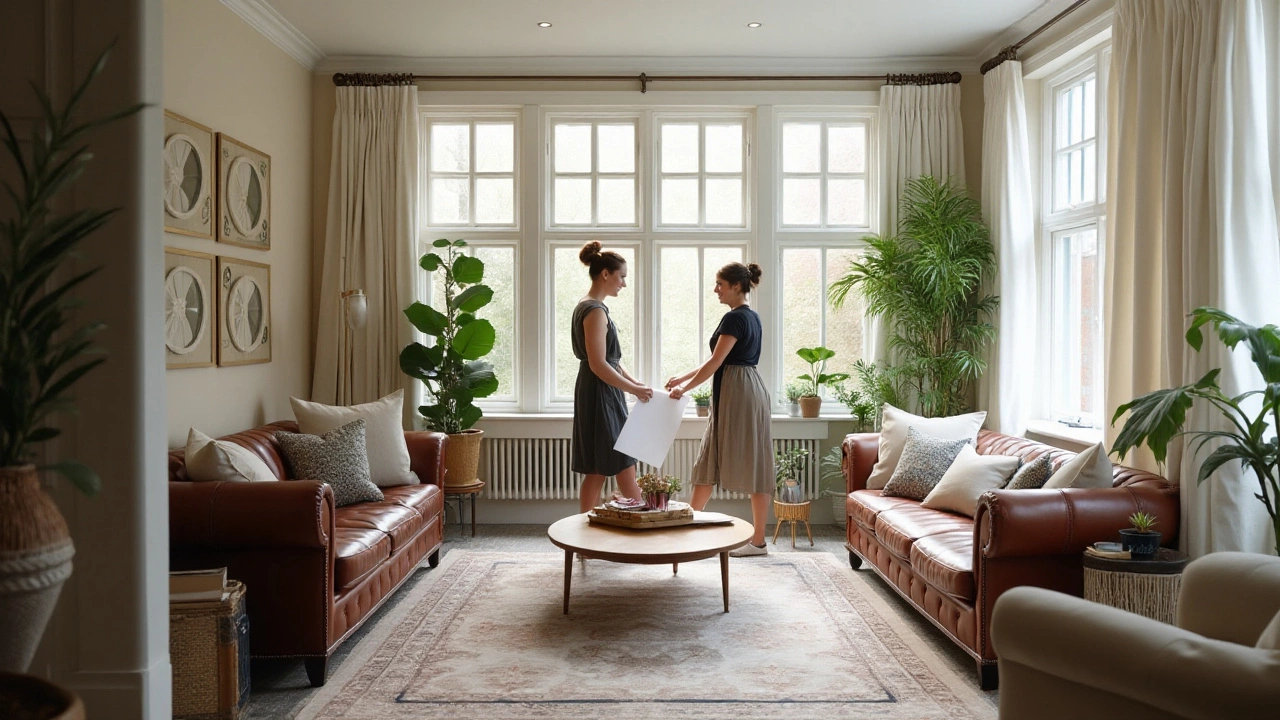
Diving into the nuanced world of interiors, the roles of interior designers and interior decorators often intertwine, yet they’re distinct in their essence. Many confuse the two, thinking they’re interchangeable, but each brings something unique to the evolution of spaces. Interior designers focus deeply on the functionality, safety, and efficiency of interior spaces, requiring formal education and training. They often work closely with architects and contractors to make structural changes or improvements.
On the other hand, interior decorators step in once a space's function and layout are established. They breathe life into structures with aesthetics, choosing color schemes, furniture, and accessories that reflect the client’s personality and style. While less involved with structural changes, they possess an innate artistic flair enriched by a keen eye for decorative detail.
Grasping these differences aids significantly when you're pulling the strings on a decorating project or a large-scale renovation. Knowing whom to call can save time, money, and ensure the outcome meets expectations beautifully.
- Understanding the Roles
- Educational Background and Training
- Skills and Specializations
- Scope of Work and Projects
- Choosing the Right Professional
- Real-Life Applications and Tips
Understanding the Roles
When exploring the vast sphere of interiors, it's essential to delineate the roles of an interior designer and an interior decorator, both pivotal in transforming spaces into functional art. An interior designer is akin to a technical artist with a deep understanding of architecture and spatial arrangements. They must merge aesthetics with construction, ensuring that every design choice harmonizes with structural elements like walls, floors, and windows. Designers craft the spatial blueprint and delve into the psychological needs of a space, emphasizing accessibility and functionality, often requiring a honed skill set developed through formal education and licensing.
Conversely, an interior decorator embarks on a journey of aesthetic refinement. Decorators work to fulfill the vision crafted by both the client and any pre-existing architectural restrictions, bringing life through furnishings, textures, and color palettes. They excel at creating ambience by layering fabrics, furniture, and accessories once the designer leaves the canvas. Decoration is about completing an atmosphere rather than rethinking its skeleton. This role demands an intuitive understanding of styles and trends, often acquired through experience or shorter training programs.
While both roles may overlap in some projects, such as choosing color schemes or layouts, their focus diverges considerably. Designers bear the weight of ensuring that a space is not just beautiful but also practical, safe, and compliant with local building regulations. 'Design is not just what it looks like and feels like. Design is how it works,' as Steve Jobs famously encapsulated the philosophy guiding effective design. This mantra is embraced by interior designers, who merge creative vision with architectural knowledge, ensuring long-lasting and safe environments for future inhabitants.
"The best rooms have something to say about the people who live in them." - David HicksContrary to the designer’s architecturally-rooted focus, decorators often don the hat of personal stylists for homes, curating a mood that reflects individual tastes and preferences. Their creations breathe life and personality into already defined spaces, making homes feel distinctive and intimate. Decorators collaborate closely with clients to understand and cater to their desired ambiance, handling tasks like selecting paint colors, sourcing window treatments, and arranging furniture.
Both interior designers and decorators cultivate environments that embody creativity and innovation, yet their methods and responsibilities remain distinct. For those embarking on a home renovation journey or looking to enhance a commercial space, recognizing when to draw on the expertise of these professionals can be invaluable. Table combines the areas of distinct expertise both professionals can be crucial, though they operate in different realms of the design and aesthetic process.
| Aspect | Interior Designer | Interior Decorator |
|---|---|---|
| Focus Area | Functionality and Safety | Aesthetics and Atmosphere |
| Educational Background | Formal Design Education | Artistic Experience or Training |
| Key Skills | Architectural Knowledge, Project Management | Stylistic Vision, Trend Awareness |
Whether transforming the heart of your home or infusing a fresh style into a classic space, the synergy between designers and decorators marries structural integrity with charming aesthetics, ensuring not only a space that works well but one that resonates profoundly with its inhabitants.
Educational Background and Training
When diving into the pathways leading up to becoming an interior designer, one would note a landscape rich in formal education, often requiring a bachelor's degree as a foundational stepping stone. This academic journey not only acquaints aspiring designers with architectural principles but also imbues them with knowledge of building codes, sustainable design, and computer-aided design (CAD) software. Such a curriculum ensures they have the technical grounding necessary to engage with architects and contractors alike. These designers are trained not only to envision a beautiful space but also to ensure it adheres to safety standards and optimizes functionality. The ability to craft a space structurally and aesthetically attests to the depth of their academic grooming.
In comparison, those who favor the promising field of interior decoration might pursue a different educational trajectory, often characterized by certificate or diploma programs. These programs emphasize color theory, textile finishes, and the arrangement of furnishings to create harmony in a space. While formal education plays a significant role, many decorators build their careers on the back of remarkable talent and refined aesthetic sensibilities honed through personal practice and self-directed learning. This dynamic interplay between formal and informal training provides a platform for decorators to cultivate their unique style while responding adeptly to client needs and tastes.
According to the International Design Continuing Education Council, "While formal credentials enhance a designer's expertise, a decorator's flair often springs from a natural artistic ability".
A deeper look into professional qualifications reveals that interior designers may seek licensure, which is mandatory in several regions, taking rigorous exams like the National Council for Interior Design Qualification (NCIDQ) as proof of their comprehensive capability. Decorators, on the other hand, may opt for certifications offered by associations like the Certified Interior Decorators International (C.I.D.), underscoring their industry commitment and expertise. Both paths equip them to tackle varied projects, but the formalities and requirements differ, reflecting their distinctive roles in the realm of interior transformation.
Gazing into the world of practical application, internships and on-the-job experience form crux components of both disciplines’ education. Designers often undertake internships that expose them to real-world scenarios, juggling client needs with technical specifics, while decorators benefit greatly from shadowing seasoned practitioners who have mastered the art of color symphonies and intricate styling. Practical experiences foster a versatile skill set, allowing both to remain nimble in their approaches and adopt innovative solutions. In New Zealand and beyond, the rich tapestry of training avenues allows these professionals to join forces in crafting spaces that are as functional as they are beautiful.
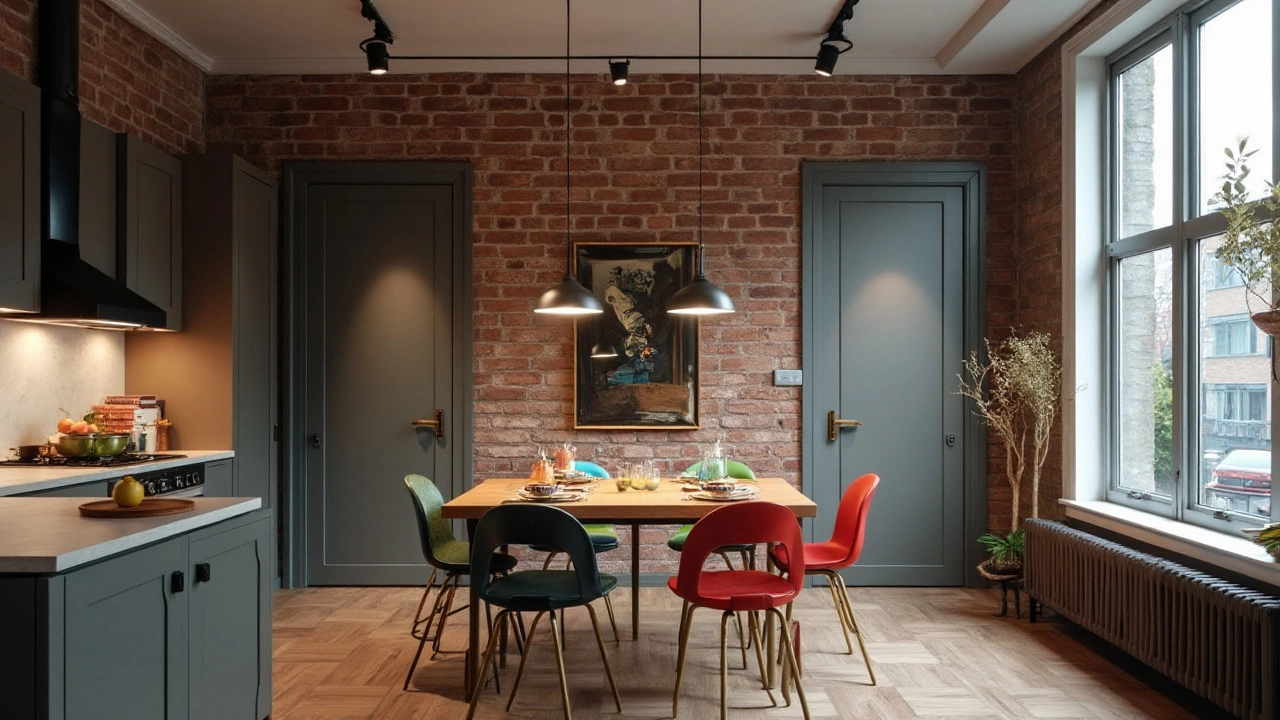
Skills and Specializations
When examining the unique skill sets that distinguish an interior designer from an interior decorator, it becomes evident that each profession requires its own distinctive set of talents and expertise. Interior designers engage with an in-depth knowledge of architecture and spatial concepts. They must navigate building codes and regulations, often working alongside architects and engineers to bring about structural modifications. This calls for proficiency in AutoCAD and similar design software, enabling them to create detailed blueprints and design plans. Their work is not just about aesthetics; it's a blend of functionality and form, ensuring that spaces are not only beautiful but also practical for intended uses.
Interior decorators, in contrast, hone their skills on the subtleties of style, color theory, and decorative trends. They are masters in the art of layering and harmonizing elements such as furnishings, textiles, and lighting. A decorator's skill is seen in their ability to transform a space with a cohesive palette and curated items that tell a unique story. They might not need the technical know-how of their designer counterparts, but their eye for detail and trend forecasting is crucial. They develop themes that speak to personal tastes and current movements, and their work is often on visible display, showcasing their ability to balance trends and timeless elegance.
Technical and Creative Skills
The technical skills of an interior designer extend into areas like sustainable design and environmental considerations, incorporating elements that enhance energy efficiency and eco-friendliness. With the growing importance of sustainability, designers are now expected to source and recommend materials that minimize environmental impact. Decorators also contribute by sourcing ethically made products and promoting brands that follow fair trade practices. While a designer grapples with intricate plans and permits, a decorator's mind is a treasure trove of creative strategies, thinking season-ahead to maintain a space's aesthetic allure. For both, constant learning and adaptation to trends are key, ensuring their skills stay ahead in an ever-evolving market.
"Design is not just what it looks like and feels like. Design is how it works." – Steve Jobs
Sometimes overlapping, the roles differ fundamentally in their approach to education and specialization. Designers often undergo formal training and may be required to pass licensing exams depending on the region, emphasizing their preparation for contracting and technical challenges. Decorators, while they may attend specialized courses, generally focus on hands-on experience, portfolio development, and client interactions. Whether you lean towards the structured, science-driven world of design or the expressive, stylistic realm of decoration, both paths offer fulfilling career routes rich with creative potential.
Trends and Adaptation
In modern home improvement, both disciplines adapt to emerging trends and evolving client needs. Designers are at the cutting edge of smart home technology, integrating modern innovations into their plans, such as automated lighting and digital room control systems. Decorators, meanwhile, embrace the accentuation of unique, personalized styles, mixing antique treasures with cutting-edge design elements to match the eclectic tastes of today's homeowners. They are tasked with mastering popular styles, from Scandinavian minimalism to bohemian flair, turning each project into a uniquely tailored experience. Lists of trending materials or color palettes are a staple in a decorator’s toolkit, while a designer’s arsenal includes sustainability checklists and structural analysis tools. This dynamic adaptation ensures that both designers and decorators meet the diverse demands of clients who wish to reflect their lifestyle and values through their living spaces.
| Skill | Interior Designer | Interior Decorator |
|---|---|---|
| Technical Design | Software proficiency (AutoCAD, Revit) | N/A |
| Regulatory Knowledge | Building codes, safety regulations | N/A |
| Creative Skills | Spatial planning, structural modification | Color theory, style trends |
| Sustainability | Eco-friendly building design | Ethical product sourcing |
Scope of Work and Projects
When considering the scope of work and projects under the banner of interior design and decorating, you're looking at two contrasting roles that complement one another beautifully within the realm of home aesthetic and functionality enhancement. Interior designers usually get involved right from the structural planning stage, which means they are a vital part of the team alongside architects and builders. Their expertise is not just an optional add-on; it’s a necessity in projects involving home constructions or significant remodeling where space planning, flow, and human behavior patterns come into play. By ensuring that the layouts are functional and efficient, they transform what could be often seen as mere walls into living experiences tailored for future inhabitants.
The responsibilities of an interior designer encompass creating detailed layouts that account for structural alterations. They prepare comprehensive design concepts that showcase projected looks, materials, and even lighting plans. For instance, if a client desires an open-concept living space, a designer will calculate load-bearing walls, ventilation paths, and acoustic properties. These specialists liaise with developers to stay compliant with building codes, offering the necessary technical drawings, procurement lists, and 3D visualizations, which serve as both plans and inspiration for the client. This hands-on involvement from the foundation avoids costly recalibrations down the line.
On the aesthetic side, interior decorators deal primarily with the stylistic overlay within these established spaces. They fashion environments that might align with defined themes or moods as requested by clients. This role zeroes in on superficial upgrades, focusing on colors, materials, and textures. Typically, they work with already fixed structures, recommending the purchase or placement of furniture, art, drapes, or accents to elevate a room’s personality. Their projects often revolve around enhancing the lived-in experience, transforming potential sterile looks into lavish or cozy environments filled with warmth, character, and dynamism.
To encapsulate their distinct value, imagine sprucing up a charming old cottage. An interior designer will tackle modifications like upgrading the electrical systems or repurposing unused spaces while retaining its architectural charm. In contrast, the interior decorator will layer this foundation with vintage furnishings and earthy tones, bringing out the period feel the homeowners adore. As the renowned design educator Jeffrey Bilhuber put it, "It's not about what you put in a room. It's all about what you leave out." This synergy is what elevates and distinguishes the practice when both professionals work together.
To compare their applications, consider the typical project overseen by an interior designer, which can stretch over several months or years for a full home design or a commercial space. These are grand concerts of engineering, style, and function, where they draw not only from design principles but a broad understanding of ergonomics and psychology. Interior decorators, by contrast, might manage a few weeks to bring a living room or boutique hospitality area to life with just the right layering of objets d'art to make an impactful yet cozy statement.
When deciding which professional to hire, it's essential not to overlook practical considerations. A helpful approach is listing out your project's specific needs: Does this endeavor require structural changes? Or is it purely stylistic updates? Knowing these answers can help significantly in allocating resources wisely between an interior designer and a decorator. Remember, a beautifully designed space is often where the line between structural precision and heartfelt coziness blur, and that balance calls for the expertise of both disciplines.
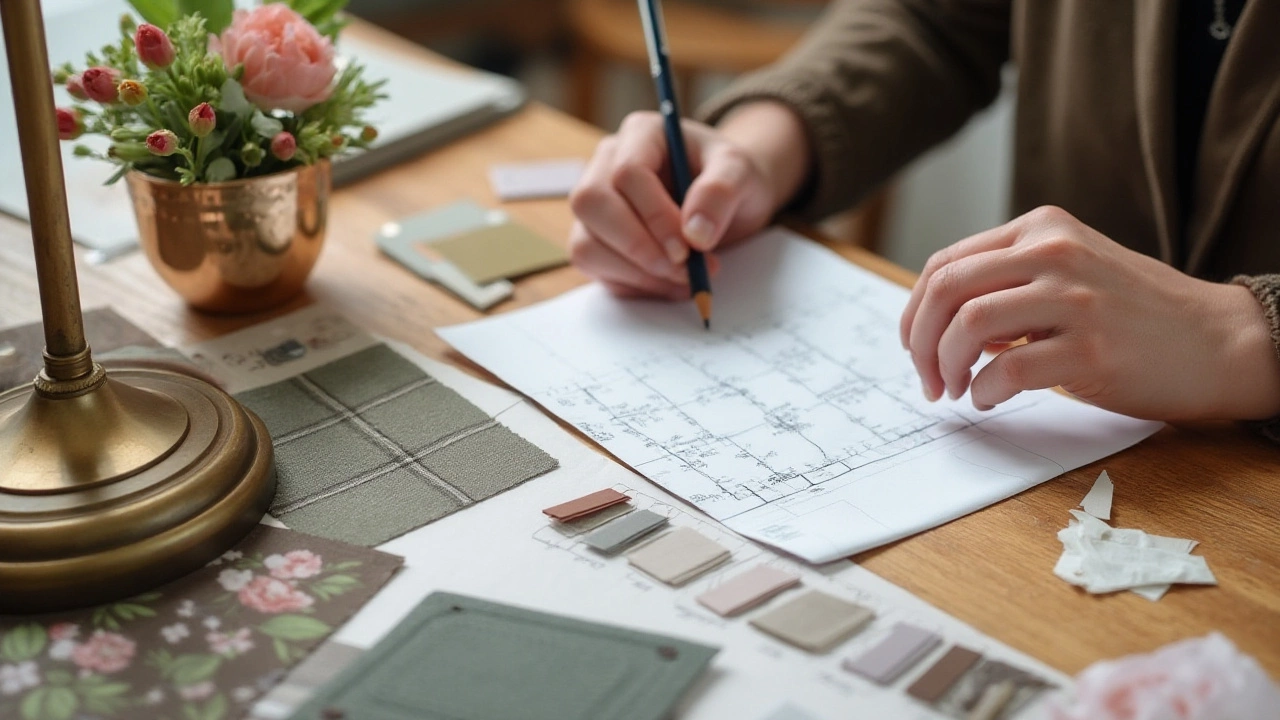
Choosing the Right Professional
When it comes to selecting the right interior designer or interior decorator for your project, understanding their distinct roles is pivotal. The first step is identifying the scope of the work concerned. If you are embarking on structural modifications, like tearing down walls or altering the function of a space, then an interior designer is the person to contact. Their involvement often extends to plumbing and electrical layouts, requiring a keen eye on both aesthetics and functionality. They ensure everything complies with the necessary regulatory standards.
Conversely, if your aim is to refresh the look of a space without altering its structure, an interior decorator might be more suited to your needs. Interior decorators bring a creative, intuitive approach to selecting color palettes, fabrics, furniture, and other elements. Their focus remains steadfast on enhancing beauty and creating cohesive themes throughout, often with an eye for incorporating current trends or timeless design elements. Decorators' insights can transform spaces through subtle yet impactful changes without the need for structural intervention.
Budget is another critical factor. Interior designers typically charge higher fees due to their extensive involvement in complex projects and their ability to command both design and technical collaboration. Ensure clarity on costs from the outset to circumvent any unpleasant surprises down the line. It’s often helpful to review portfolios, public reviews, and testimonials to match the professional's style with the vision you hold. Personal recommendations from friends or colleagues who had similar projects done can also serve as a reliable guide.
A proper analysis of what you want can help you in choosing between these two professionals. A well-structured brief really helps; it could include detailed descriptions of what you envision, inspirational images, and a realistic timeline for the project’s completion. Consider creating lists of must-have items and compromises you are willing to make should budget restraints arise. These preparatory steps not only communicate clarity to the professionals but also help them in providing an accurate estimate and approach tailored to your exact needs.
Moreover, communication is key. Whether you're working with an interior designer or an interior decorator, conveying your tastes, dislikes, preferences, and expectations fosters a collaborative atmosphere. Professionals draw on their expertise but ultimately aim to realize your vision. Regular communication can illuminate any misunderstandings early and ensure adaptations fit within the framework set by both parties. Do not hesitate to ask questions – a good designer or decorator welcomes inquiries and concerns.
"Good design is all about making other designers feel like idiots because that idea wasn’t theirs." – Frank Chimero
Taking advantage of technology can also enhance your collaboration with these professionals. Numerous digital tools exist, allowing you to visualize changes and experiment with different layouts or color schemes. Remember, both interior decorators and designers see your space as a blank canvas brimming with potential. Their combined efforts can turn any dwelling into a haven that feels uniquely yours, creating an atmosphere you'll revel in.
Real-Life Applications and Tips
Whether embarking on a small decor tweak or a full-blown interior transformation, knowing how to efficiently utilize the strengths of an interior designer or an interior decorator can make a remarkable difference. Imagine stepping into a beautifully orchestrated home, where each room tells a coherent story—this is the magic these professionals can orchestrate. Let’s delve into how you can apply this knowledge effectively and optimize your interior projects for success. When starting a renovation or new build, an interior designer's role is indispensable. They are not just about pretty finishes; they ensure that the space is optimized for usability and safety. From drafting layouts that optimize natural light to selecting materials that endure family life, their input has a long-lasting impact.
Designers frequently collaborate with architects and builders to reconfigure walls, wiring, and plumbing, sometimes creating open layouts that maximize space flow. A key tip for engaging an interior designer is to clearly communicate your lifestyle needs and constraints. Discussing details such as household routines, future family plans, or accessibility concerns can heavily inform design choices. Presently, there's an increasing push toward sustainable design—interior designers are transforming spaces with energy-efficient lighting, reclaimed materials, and eco-friendly finishes. A 2023 study by the U.S. Green Building Council found that buildings with sustainable interiors see 20% higher occupancy rates. Making sustainable choices not only lessens environmental impact but often translates into long-term cost savings.
On the other hand, once the bones of the building are set, the expertise of an interior decorator becomes invaluable. They excel at transforming functional spaces into personal sanctuaries by artfully selecting furnishings and accents. For instance, a decorator might enhance a living room's mood by incorporating soft textiles in muted tones balanced with vibrant art pieces that spur conversation. As decorator Carolyn Roehm once said,
"The details are not the details. They make the design."Thus, attention to detail can elevate even the simplest pieces into focal points of elegance. If budget constraints are a concern, a savvy decorator can suggest versatile investment pieces, such as a classic solid wood table that anchors a room or lighting fixtures that blend aesthetic with functionality.
When choosing between a designer and a decorator, consider the project scale and goals. Is structural change necessary, or is a visual refresher sufficient? For large projects requiring technical changes, a certified interior designer is essential. On the flip side, if your focus lies in updating aesthetics without structural alteration, an experienced interior decorator will fulfill your needs beautifully. One practical tip is to compile inspiration boards highlighting your favorite styles or sought-after feelings for your space. Whether through Pinterest or a collage of magazine clippings, this visual roadmap can bridge the gap between your vision and your professional's expertise.
